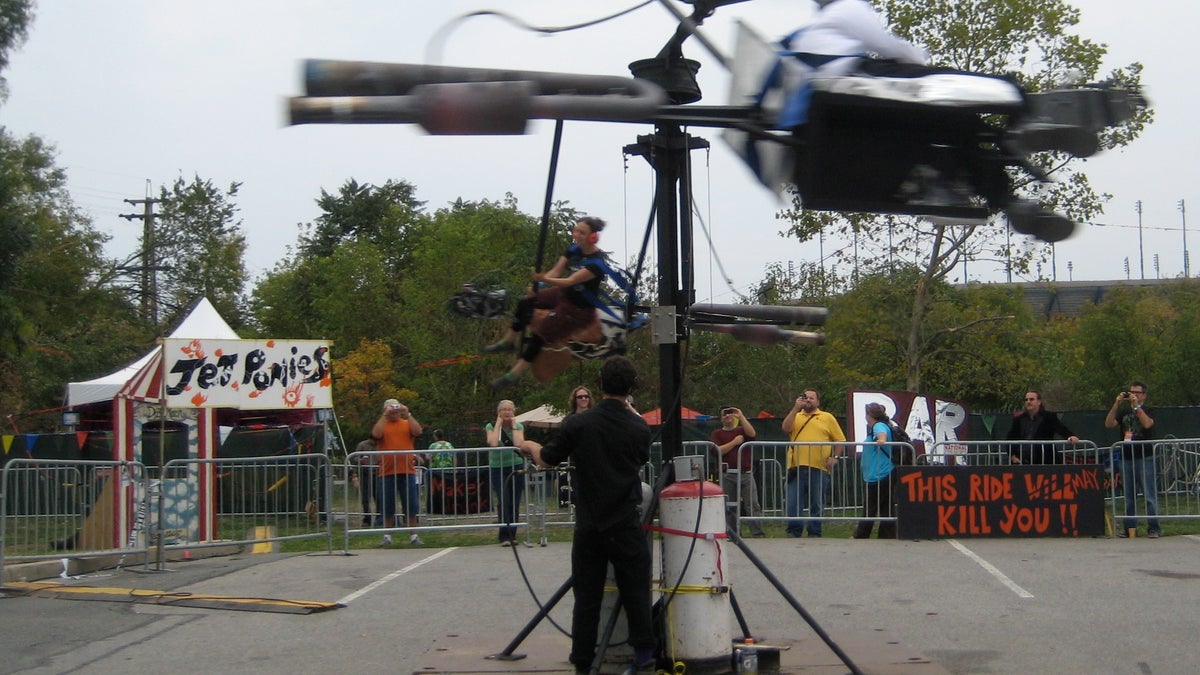Does science education need a dose of danger?
Mad scientists abound at World Maker Faire, from morbid carnival-ride builders to Tesla coil musicians. Kids' science education could get a boost from this, even if safety waivers have to be signed in the process.

QUEENS, N.Y.--Under the shadow of the Cold War-era Titan II and Atlas rockets set up outside the New York Hall of Science, this weekend's World Maker Faire extravaganza was, more than anything, a tribute to the more colorful fringes of hands-on innovation, science, and engineering. And the "makers" who populated its tents and booths wanted nothing more than to get the thousands of children in attendance interested in physics, engineering, biology, and even metalwork.
The kids were enthralled. This was not the kind of science you saw in a textbook: there were exploding chemistry experiments, flame-throwing robots, model rockets, lessons in laser cutting and soldering, and a perpetual whir and hum of jet engines that made one man comment, "Sounds like a large vuvuzela." Parked in the middle of the outdoor exhibits was the BioBus, a repurposed school bus that's now loaded with microscopes so that kids can learn about cell biology, including a tissue sample donated by comic television pundit Stephen Colbert.
Even the most offbeat exhibits, staffed by costumed hipsters and artists whose look was far more Burning Man than Bunsen burner, played up the importance of science education. "Can I get a big shout-out for math?" artist Mark Perez asked to a crowd of hundreds of eager children and parents who were about to watch him orchestrate the Life Size Mousetrap, a 50,000-pound feat of mechanics that took Perez a decade and a half to build and which spent the weekend using a two-ton safe to smash a taxi.
Explaining the machinery and workings of the Life Size Mousetrap, Perez gleefully played up the fact that many components were extremely heavy, unstable, or potentially dangerous. "This, folks is why I can't get insurance!" he proclaimed.
With all the outcries from Silicon Valley titans that U.S. schools aren't producing the engineers and scientists at the rate that the technology industry needs, a let's-get-rowdy science festival like the Maker Faire brings up an interesting, and potentially controversial point. Maybe science education needs a lot more of the stuff that could send squeamish parents running for the hills. Perhaps the ranks of young future scientists are being thinned by the filter of a world in which the nightly news convinces us to believe that kids are at risk from everything from walking into the backyard unsupervised to logging onto their instant-messaging clients, and in which a combination of budget cuts and safety concerns means that chemistry and physics equations often never get the chance to jump off the textbook page.
Just earlier this month, a coalition of tech CEOs joined the Obama administration in launching Change The Equation, founded by the likes of ex-Intel Chairman Craig Barrett and Xerox CEO Ursula Burns among other chief executives, and backed by the Bill and Melinda Gates Foundation. Last week, Facebook CEO Mark Zuckerberg announced a $100 million donation to the public school system in troubled Newark, N.J., that marked the launch of his own education-focused initiative, Startup: Education.
With all this education reform talk, supporters might want to keep in mind the likes of Maker Faire and the expressions on children's faces as they saw the
Some educators seem to be clued in. One of the more "serious" setups came from Manhattan-based John Jay College of Criminal Justice, which had constructed a sort of pop-up education center for kids to learn about forensic science and crime scene analysis. This involved a fake crime scene with a pair of bloody corpses, displays about blood-spatter analysis, and T-shirts with bullet holes to explain differences in varieties of firearms.
The more irreverent exhibits were in-your-face risky. An artists' collective in Brooklyn, the Madagascar Institute, had set up a pasture of intentionally terrifying carnival rides with names like "The 360-Degree Swing Of Death" and hand-painted signs that reminded visitors "Safety Third!" "This Ride May Kill You," and "Fear Is Never Boring."
The Madagascar Institute, of course, is purposely pushing it. But if Maker Faire is any indication, science for kids doesn't have to be boring, either.

